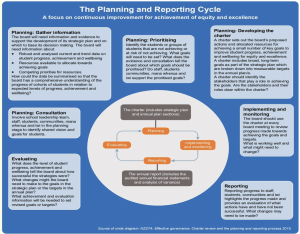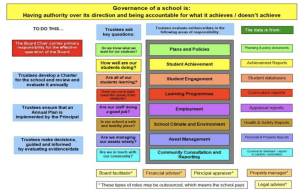He rei ngā niho, he parāoa ngā kauae
To have a whale’s tooth, you must also have a whale’s jaw: To hold the mantle of leadership, one must embody the true qualities of a leader.
Module Objectives:
- Understand governance structures in education.
- Master reporting requirements.
- Develop effective reporting skills.
- Ensure accountability and transparency.
- Understand compliance with regulations.
- Apply ethical principles to governance and reporting.
For all kura there is a ‘truth’ about who they are, how successful they are in the provision of learning outcomes and how they manage the resources, financial and otherwise in that provision. This includes their culture, academic performance, and their potential to provide for the learning and well being of both students (akonga) and staff and their engagement with, and in representation of, their community.
There are multiple lenses through which this ‘truth’ can be observed and performance measured through time and it is these multiple lenses which the Principal is responsible for keeping polished and focused. The focus being not what reporting looks like but why it is structured in the way that it is and how Principals best ensure delivery on reporting outcomes.
Section 1: In School Reporting
The diagrams below provide potential overviews of how reporting on progress is scaffolded within a school, including where the various layers of school leadership assume responsibility, and where the governance role takes over from management, at the point where the Board of Trustees is involved.
While these diagrams are simplistic they clarify the planning and reporting flow that lies behind the annual report, and the external ERO reviews, and the relevance and reliance each has on the other. They show the reporting chains designed to capture an authentic picture of school progress and future planning.
They also connect planning at each level, the setting of school direction, with the compliance pathway to government legislation (The Education and Training Act 2020) and set out where accountability should be visible.
This module invites you to examine aspects of the ‘official’ pictures of school performance, the reporting part of the strategic management and reporting cycle and provides you with the opportunity to reflect on either the shorter annual and internal mechanisms to capture delivery and engagement with the school community (charter, annual plan, analysis of variance) or the longer term external review cycle that determines how the school is sustaining delivery and engagement (ERO reports, MoE statistics).
As well as the references provided, you may need to access your kura’s latest ERO report, current charter and latest Analysis of Variance and Annual Report.


Resource 1: School Planning and Reporting Framework
Resource 2: Toolkit on school planning and reporting for school boards, principals, and staff
Section 2: External Reporting
Resource 3: “How ERO Reviews”
https://ero.govt.nz/how-ero-reviews
Task:
There are two options for this activity, to work either focus on in-school or external reporting. You need only respond to one option although you may wish to explore both for your own professional learning.
The readings provided give background to both the planning and reporting cycle and also to the functions of the ERO interface with schools. Given the nature of reporting at this level you may need to gather data for your response in discussion with your Principal and/or Board Chair.
In approx 150 words either:
EITHER: In-School Reporting
Use page 60 and 61 of the above document (https://web-assets.education.govt.nz/s3fs-public/2024-09/Te-Whakangarahu-Ngatahi-Toolkit-on-school-planning-and-reporting-for-boards-and-principals-September-2024.pdf?VersionId=odPTebMqtwU1HyVxfMEnWOm5sakVtmnY) to reflect on your kura’s progress last year. Talk with your principal or learning partner about your reflections. Post the key reflections from this discussion on the forum.
OR: ERO Reporting
Working with your school’s latest ERO report, reflect on the review process, the recommended changes from that report and the subsequent work done to adjust and refine the planning and reporting cycle in your school. Talk with your principal or learning partner about your reflections. Post the key reflections from this discussion on the forum.
Assessment:
- Completion of all readings.
- Discussion with your principal or learning partner.
- Participation in the online forum discussion.

11 Responses
Key Reflections on In-School Reporting Structure
Our current structure—BOT meetings occurring twice per term, with the Principal’s report leading the agenda—provides timely oversight, but the quality of reporting hinges on its focus and the data presented.
Shifting Focus to Outcomes: Reporting must remain analytical, showing the direct impact of key programmes (Structured Literacy/Maths) using formal data like e-asTTle and NCEA results. This analysis must explicitly drive our PLD planning, demonstrating the return on investment for staff development.
Priority for 2025: For this year, our key reflection is to ensure all staff are equipped to deliver Structured Literacy and Maths programmes in the junior end of our school, as well as the NCEA changes for the senior end of the school. This is essential to ensure we deliver consistently across the kura and meet the expectations set by the refreshed curriculum.
Good to see that the timing and focus for your ERO review was useful and opportune for you and your Deans and that your future focus in responding to the areas for development will also take you in the direction that interests you.
ERO Review Experience
Last year, in my role as Acting Principal, I had the opportunity to work closely with the Education Review Office (ERO) during their review process. We engaged with the School Improvement Framework (SIF) tool, working through it collaboratively with staff. This was an incredibly valuable process that enabled staff to clearly understand where we were positioned in relation to the framework’s key indicators.
One of the most positive outcomes was that, although staff worked in smaller groups, there was strong alignment in their assessments, reflecting a shared understanding and united vision for the school’s direction. Staff could see that our school was tracking well, and this brought a sense of confidence and collective ownership.
This approach was both constructive and collaborative, marking a significant shift from previous ERO visits. Rather than being evaluative in nature, the process felt more like a partnership—focused on growth and improvement. A key area highlighted, consistent with Ministry of Education priorities, was student attendance. This validated the work we had already begun as a school in addressing this issue.
Importantly, staff reported that the process deepened their understanding of:
– The role and purpose of ERO,
– Our school’s strategic direction,
– And the importance of aligning policies, procedures, and compliance requirements.
Overall, this ERO engagement was a highly valuable professional learning journey for our whole team and helped strengthen a culture of reflection, transparency, and improvement.
Great to hear how effectively the new ERO approach worked for your Kura and congratulations on leading them on such a positive journey
In-School Reporting and Data Analysis
At our kura, we report to the Board twice annually, presenting comprehensive data that is broken down by year groupings and key target groups. These reports also include reflections on relevant contextual factors such as gender and ethnicity. The insights drawn from this data inform our identification of target groups and the planning of professional learning and development (PLD) to enhance student progress and achievement.
Over the past few years, analysis of school-wide data—alongside the implementation of structured literacy—has highlighted literacy, particularly writing, as a key focus area in the Primary School. In response, we are aligning our practices to ensure students are well-prepared for future learning, including the expectations of the corequisite literacy standards.
In my role as Deputy Principal and Head of Primary, I have played a key part in the development and analysis of these reports. This includes identifying trends, setting achievement targets, and contributing to strategic planning that supports staff and student success across the Primary School.
Effective use of data is key to successful outcomes for students, and identifying, and then acting on, insights and trends gives you an authentic and solid foundation for change.
In school reflection on 2024 Data.
When reflecting and reviewing our data from 2024 some key points came out regarding our progress over the course of that year. Firstly, as a school our SMS system has specifically set up for our school and the NZC. We provide clear expectations around real time reporting to whānau and setting clear goals for the students that should be updated regularly.
During the data analysis, it was clear that some areas of the school were better at following this process better than others. It was also clear that assessment protocols and follow-up from team leaders varied considerably across the Kura as well.
As a school our reporting and assessment protocols ask for a variety of different tools to support overall OTJ’s and SLT set clear targets and expectations that align with and our strategic goals/targets. The leadership team spend a lot of time following and tracking these targets and the clear difference between these and the general oversight by middle leaders is something we have had to highlight as a priority moving forward.
While our overall data is consistent with previous years and the current BOT are happy with our progress and general data, our reflection and analysis of the 2024 data inline with the refreshed curriculum, we are now in a position to make some changes to better support our Kura.
Great processes followed Brett, and you highlight a key issue, consistency of performance across the Kura in following systems and communicating goals to each other and to students. The time spent is well invested, even as more change is proposed from outside forces. You start with sound knowledge and understanding.
Key reflections on our ERO review and 2024 student reflection (alongside my Principal) – I did both as I thought both were good for my personal development and it made for a good conversation with my Principal.
Our recent ERO review, a collaborative partnership, focused on data, acceleration, student well-being, and inclusive practices. Pre-visit document sharing promoted focused discussions and an alignment of thinking. The on-site review included compliance checks, ELL student interviews, Board, SLT discussion and classroom visits.
ERO’s negotiated recommendations aligned with our own, emphasising attendance, student progress, data success, and strengthening Te Reo Māori and Tikanga integration.
We are addressing these through strategic and curriculum plan revisions, and targeted professional development. Our strategic planning, actions and reporting now explicitly incorporates ERO’s feedback, ensuring sustained improvement and alignment with Ministry priorities. This collaborative process has reinforced our commitment to continuous enhancement.
Overall Achievement (End of Year 2024):
Reading: 89% of all students are at or above their year level expectations, a 3% increase from 2023.
Writing: 85% of all students are at or above their year level expectations, consistent with 2023.
Mathematics: 94% of all students are at or above their year level expectations, a 2% increase from 2023.
Key Observations and Disparities:
Writing:
-A 9% disparity exists between girls and boys’ achievement.
-Māori student achievement in writing is 77%.
-Year 2 students have the highest proportion of students working below expectations at 29%
-Year 3 presents an anomaly, with only 10% achieving ‘above’ in writing, despite 34% achieving ‘above’ in reading, and a 12% writing acceleration rate. The overall achievement rate for year 3 is 84%.
Mathematics:
-Māori student achievement is 84%, indicating a 10% disparity.
-Year 5 students are the lowest achieving cohort at 86%.
-Girls outperform boys in mathematics. (95% to 91%)
Well done on your reflection on the ERO review and findings. It is great that this has been useful for you and that is has fed into whole school planning. It is a valuable process when the feedback if future focused and gives direction to the areas where progress needs to be made.
Key Reflections on the ERO Review Process
Our most recent ERO report (July 2024) was constructive and collaborative, with a strong focus on improvement rather than judgment. It highlighted key areas for development, including:
– Improving Pacific student achievement
– Increasing attendance rates (particularly for Māori and Pacific learners)
– Strengthening the integration of te ao Māori
– Building teacher capability, especially for priority learners
In response, we’ve refined our annual goals, embedded teacher inquiries more deeply into PLD, introduced targeted attendance monitoring, and begun more purposeful integration of te ao Māori in our local curriculum.
Personally, I’m excited to see te ao Māori being more intentionally woven into our practice- I have for a long time felt like this was a gap at our school, so it’s great to see some progress already being made since the ERO review came out. I also feel we’re building real momentum in teacher capability while recognising that this is ongoing, evolving work.
In discussion with my Year 7 and 8 Deans, we agreed that the ERO process came at the right time in our curriculum refresh journey. It affirmed the direction we’re heading and reminded us of the need for flexible, responsive planning- especially in relation to equity and student engagement.